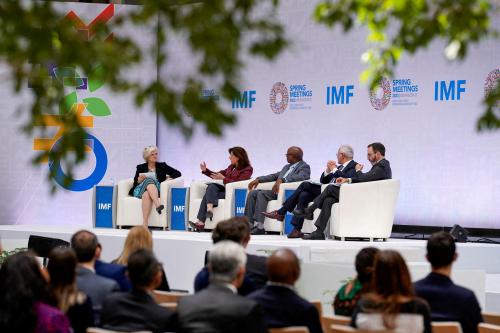Over the past several years, an increasingly strong voice has risen in China calling for the reform of its foreign aid policies and systems. In response to this voice, the Ministry of Commerce (MOFCOM) initiated a campaign in 2014 to “comprehensively deepen the reform of China’s foreign aid system,” which led to the release of new “Measures for Administration of Foreign Aid” in December. Under this grand scheme, MOFCOM is scheduled to introduce mid- to long-term policy guidelines on Chinese foreign aid in 2015. While the changes to China’s foreign aid may not be as drastic as some have hoped, they will nonetheless affect the direction and practice of China’s foreign aid as an important policy instrument.
In China, there is now a general consensus that China’s foreign aid needs reform. The past decade has witnessed a great proliferation of foreign aid actors—from government entities to private companies to individuals and social entities—and a significant rise in foreign aid volume. China’s cumulative foreign aid between 1949 and the end of 2009 was 256.29 billion RMB (around $43 billion using the exchange rate of 2009), while the total amount between 2010 and 2012 was 89.34 billion RMB. This means that more than a quarter of the aid provided by China from 1949 to 2012 happened during the last three years of that period. The demands and expectations of recipient countries have also diversified, covering a broad range of areas including technical assistance, capacity building, and infrastructure projects.
As a non-OECD (Organization for Economic Cooperation and Development) country, China’s growing foreign aid has been having a significant impact on the landscape of the global development community. Chinese foreign aid has become a formidable alternative to existing Western aid. Multilateral development institutions championed by China such as the New Development Bank and the Asian Infrastructure Investment Bank (AIIB) are raising important questions about the future of existing institutions, including the World Bank and Asian Development Bank. As China dives into these new territories of multilateral development institutions, it also needs to adjust for discrepancies between its traditional bilateral-focused aid practice and the prevailing international norms.
In addition, in the past decade, controversies stemming from China’s foreign aid, especially business contracts in less-developed countries and connections to China’s quest for natural resources, have solicited scrutiny and criticism from international observers. How to manage the reputational risks associated with commercial aspects of China’s foreign aid and improve its foreign aid to better serve China’s broader national interests is a key task identified by analysts within the Chinese foreign policy community.
There is some degree of consensus among Chinese observers and scholars regarding the needed foreign aid reform. For example, most agree that China needs legislation on foreign aid from the National People’s Congress to replace the less formal and less authoritative executive orders and ministerial measures currently guiding the country’s foreign aid policy and practice. At the technical level, it is generally agreed that China needs more foreign aid professionals specializing in international development and better monitoring and evaluation (M&E) for the implementation of its aid projects. International development is a relatively new field for Chinese universities and academic institutions. Many if not most foreign aid staff in China today comes from a foreign language or international relations background. Their knowledge deficiency has limited the scope and depth of the mission they are expected to perform. Furthermore, monitoring and evaluation has not traditionally been a strong priority for China’s aid programs, especially beyond the completion of infrastructure projects.
Beyond this consensus, major disagreements persist. People debate the priorities of China’s foreign aid. Concessional loans, such as those on large-scale infrastructure projects, have recently become the largest component of China’s foreign aid, occupying 55.7 percent of China’s total foreign aid between 2010 and 2012 (between 1949 and 2009, the percentage was only around 28.7 percent). However, prominent observers inside China such as Xu Weizhong from China Institute of Contemporary International Relations have been calling for China to steer its foreign aid away from this model and more toward capacity-building and social welfare projects. This shift would foreseeably dilute the image of China using foreign aid to advance its commercial interests, yet it would also inevitably hurt those interest groups embedded in the approach.
Furthermore, the effort to shift the focus of China’s foreign aid away from infrastructure projects may not be in line with the current priorities of the Chinese government. As MOFCOM has stated, in the foreseeable future China will enhance its foreign aid to countries along the “One Belt, One Road” and in China’s periphery. Given the “One Belt, One Road” initiative’s overall emphasis on “connectivity” (infrastructure projects such as transportation networks), it is reasonable to expect that concessional loans for infrastructure projects will receive favorable consideration in China’s foreign aid in the years to come.
The diversification of aid actors and the role played by Chinese nongovernmental organizations (NGOs) remains a catch-22 for Beijing. The Chinese government acknowledges and desires the role played by some Western civil society organizations and NGOs in international development, especially in terms of their political independence, credibility, transparency, and creativity. However, given the Chinese government’s tendency to dominate the decision-making and implementation of aid projects to ensure their political and economic “correctness,” the role played by Chinese NGOs is at best minimal and marginal. The few Chinese NGOs involved in aid projects are often perceived as subsidiaries or policy implementers of the Chinese government, serving mostly propaganda purposes. Without significant changes to the current foreign aid structure, it is unlikely that Chinese NGOs could play a key role in China’s foreign aid.
There is a great deal of hesitation on China’s part with regard to aid cooperation with traditional donor countries and organizations. On one hand, China is concerned that such cooperation might enmesh China in the Western foreign aid discourse and system, thereby potentially making China’s foreign aid budget vulnerable to Western exploitation against China’s national interests. Furthermore, while China is already struggling to maintain its identity as a developing country, cooperation with developed countries on foreign aid could jeopardize that effort. On the other hand, multilateral aid cooperation offers China opportunities in capacity building and enhances China’s voice in the global development agenda. China has had some successful cooperation with the U.S., U.K., and Australia in low sensitivity areas such as agriculture, health, and disease control in less-developed countries. The China-led AIIB has also expressed the desire to work with the World Bank and Asia Development Bank in their development projects. It is safe to assume that trilateral/multilateral development cooperation will become increasingly popular for China’s foreign aid, although the specific path, model, and coverage will be contingent upon major internal deliberation and external negotiation.
Debates over technicalities do not disguise the fundamental issue of the association of China’s foreign aid with its commercial interests. In other words, China needs to decide whether or to what extent it will separate the non-commercial aid programs from those with a commercial portfolio. For the bulk of China’s foreign aid—the concessional loans—only the difference between the concessional loan interests and market interests is covered by China’s foreign aid budget. However, the setup helps to enhance the desirability of Chinese loans, obtain service contracts for Chinese companies, and secure returns in various forms, including natural resources. Although this “tied aid” practice is not unique to China, it does blur the distinction between altruistic foreign aid and mercantilist commercial endeavors. For China’s foreign aid reform, the essential question is what distinction and clarification the central government is willing to make.
This is also the fundamental issue underlying the bureaucratic reform of China’s foreign aid system. Currently, China’s bilateral foreign aid is primarily managed by MOFCOM. This bureaucratic setup naturally leads to suspicions, justified or otherwise, that China’s foreign aid is heavily influenced by commercial considerations. One proposal made by many Chinese analysts to address this and the aforementioned technical challenges is to establish a Chinese Agency for International Development (or a General Administration of Foreign Aid) to comprehensively manage the country’s foreign aid.
However, given the lengthy nature of China’s foreign aid reform and the vested interests associated with the current setup, few expect the top leadership to make any drastic moves in the near future. Nevertheless, technical reforms, internal adjustments, and enhanced multilateral cooperation are indeed on the horizon for China’s foreign aid.
Africa, as a primary recipient of Chinese foreign aid, is inevitably going to be affected by these reforms. On a strategic level, the rising voice on the need to emphasize the “aid” rather than the commercial aspects in China is gradually influencing the thinking and making of China’s foreign aid policy. China is already enhancing its input in capacity building in less-developed African countries through vocational schools and technical training. The momentum is expected to strengthen by this aid reform. This facilitates cooperation with more experienced traditional donor countries and multilateral development institutions while improving the technical capacity of China’s own foreign aid system and staff. However, China may not shift the bulk of its foreign aid away from concessional loans for infrastructure in the near future. Nevertheless, combined with China’s development financing, these financial resources will be highly valuable for Africa’s vast infrastructure development demand.
It should be noted that, although China’s foreign aid reform is primarily a domestic campaign, recipients, especially African countries could play an important role in shaping the discourse. To fully utilize China’s foreign aid resources and potential, African countries should not stay passively as mere recipients, but actively voice their needs and concerns. Only through interactive and collaborative efforts could China’s aid to Africa be shepherded for the maximum benefits for the recipient countries. If there is one voice that China’s aid community cannot afford ignore, it is that of Africa itself.



Commentary
China’s foreign aid reform and implications for Africa
July 1, 2015